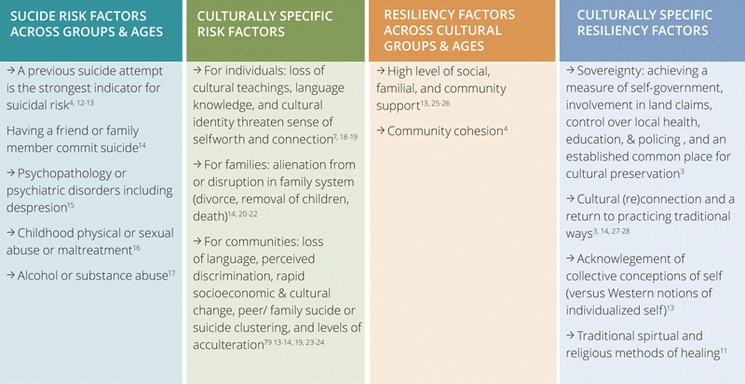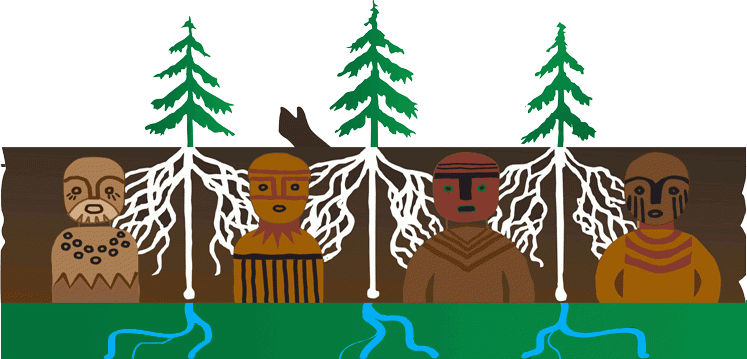Brief 04 - Indigenous Suicide: Risk & Resiliency Factors
Written by Emma ElliottSuicide is a critical and tragic public health concern. According to the World Health Organization, nearly one million people die from suicide around the world each year1. For American Indian/Alaska Native populations within the United States suicide is the 8th leading cause of death across all ages. For non-Indigenous populations, suicide is the 10th leading cause of death across all ages, 2nd leading cause of death for people aged 10-34. This rate is 2.5 times higher than the national average for that age group (2).
Notably, suicide does not affect each community equally (3). While some communities experience high rates of suicide, it is virtually unknown in other communities. Thus, it is important to recognize the risk and resiliency factors associated with suicide by engaging community specific strategies as well as identifying common best practices across cultural groups.
SUICIDE RATES FOR AMERICAN INDIAN/ALASKA NATIVE POPULATIONS (2)
|
8th |
2nd |
2.5 times |
LEADING CAUSE OF DEATH ACROSS ALL AGES. |
LEADING CAUSE OF DEATH FOR INDIGENOUS PEOPLE AGED 10-34. |
HIGHER THAN THE NATIONAL AVERAGE FOR THAT AGE GROUP |

IF SOMEONE YOU KNOW IS SUICIDAL:
- Listen and show that you care without shaming or minimizing the person’s feelings
- Stay with the person
- Find out the level of risk. Is there a specific plan? Does the person have means to carry out the plan?
- Determine if there is a history of depression or suicidal behavior running in the family
- Offer to help the person find professional help, and make sure to follow through
- Find out your community’s specific traditional or cultural responses to depression, illness, or loss
Adolescent Specific Risk & Resiliency Factors
Indigenous adolescent identity development is a complex issue that is informed by many cultural, historical, political, and social influences. Some scholars suggest that Indigenous adolescents are growing up in a more geographically and historically distinct environment than any other cultural group.
GEOGRAPHIC LOCATION: An adolescent's geographic location will inevitably affect the experiences that are offered within his/ her/their cultural community such as whether or not they are on reserve or off reserve, located in an urban area or a remote area, have access to equitable education and job opportunities4, and whether or not their land is being violated and polluted (e.g. uranium mining, Keystone pipeline)5. In addition, one's geographic location will also determine whether or not they have access to elders, traditional knowledge, or other traditional activities.
ENCULTURATION: One's individual or collective cultural identity, when fractured, places the individual or community at specific risk to suicide3. Opportunities for participating in one's culture vary depending on individual location and personal level of enculturation; these contextual influences are directly related to one's sense of cultural identity and belonging in a collective community.
COMMUNITY LEVEL FACTORS: The health of the community, which includes the financial and political resources available to the community aimed at supporting the survival of sustainable Indigenous communities, will inevitably affect individual identity development. If the community is economically self-sustaining, it is likely that youth will have opportunity for individual development, education, and/or training, which will impact their possible futures. Further, economic self-sustainability will affect the health and mental health services, child welfare services, housing, traditional food and hunting practices, and tribal policing/judicial systems that are available to young people and their families. When provided with a supportive community environment, which includes factors of economic viability, young people will have a greater chance of securing a positive sense of self-identity.
COMMUNITY SPECIFIC CULTURAL INTERVENTION AND PREVENTION STRATEGIES: Culture can serve as a protective factor against addiction, suicide and community breakdown5. We strongly recommend that organizations take into account the need to add culturally appropriate modification to their literature and programming as a means of violence prevention. The more that communities feel akin to the information being shared and the skills being taught, the more likely they will be able to use that information to their benefit. We recommend that all agencies and interventionists, take a community engagement approach to modifying their literature to be culturally sensitive and applicable.
Things To Consider
CULTURAL CONCEPT OF PERSON (6): Many Indigenous peoples conceptualize their implicit model of self based on a cultural concept of person. An Indigenous conception of self is closely interrelated with others, the natural world, and connection to the spirit world or ancestors. In contrast, Euro-American conceptions of self are influenced by an individualistic or egocentric views of self. Ontological views inevitably interact with one's sense of identity, belonging, and development and help shape one's perception about his/her/their own future. For Indigenous peoples, there is significant emphasis on a sense of collective responsibility and cultural continuity. The Indigenous conception of self is closely related to one's family, cultural traditions and knowledge, and belonging to a collective community; understanding the unique cultural, historical, and ontological context of Indigenous peoples may help us understand why some Indigenous peoples suffer from higher suicide rates than any other identifiable population.
HISTORICAL CONTEXT: The loss of culture and the history of traumatic events have had a lasting impact on Native individuals, families, and community7. The history of trauma includes separation from land through the federal creation of reservation policy as well as separation from their children through residential schools8-10. Federal policies such as the Indian residential school program aimed to strip Native American peoples of their language, culture, land, and practices11. Children returned back to their family homes without the cultural teachings. When tasked with socializing their own children, residential school survivors are faced with the dilemma of how to transmit cultural values, beliefs, roles, rules, and moral guides often without having experienced what it means to be a part of a family or a cultural community (12).
Critical Reflection
→ What are the traditional healing and helping ways in your community?
Considerations For Practitioners
As community caregivers, it is our ethical responsibility to balance historical events, contemporary symptoms (e.g. poverty), and oppression when working with Indigenous clients. When we can balance these three factors, we can help the individual make sense of their experiences. Practitioners must acknowledge the collective and cumulative emotional wounding that has resulted from historically traumatic events and the residual effects of colonization.
If we do not acknowledge how these forces operate in the background, we are not serving our Indigenous clients ethically. Without accurate or complete knowledge of the history, we may respond with indifference, disbelief, avoidance, repression, and denial of the community’s historical experiences; these responses serve to exacerbate the patient’s trauma response.

References
1. World Health Organization (2014). Mental Health: Suicide Prevention. Retrieved February 11, 2014 .
2. Center for Disease Control (2012). Suicide: Facts at a Glance. Retrieved February 9, 2014 from CDC site.
3. Chandler MJ, Lalonde C. Cultural continuity as a hedge against suicide in Canada’s First Nations. Transcultural Psychiatry. 1998; 35(2): 191-219.
4. Freedenthal, S., & Stiff man, A. R. (2004). Suicidal behavior in urban American Indian adolescents: A comparison with reservation youth in a southwestern state. Suicide and Life-Threatening Behavior, 34(2), 160-171.
5. Chandler, M., & Lalonde, C. (1999). Cultural continuity as a hedge against suicide in Canada’s First Nations. Violence & Abuse Abstracts, 5(1).
6. Kirmayer, L. (2007). Psychotherapy and the Cultural Concept of the Person. Transcultural Psychiatry, 44(2), 232-257.
7. Kirmayer, L. (1994). Suicide among Canadian aboriginal peoples. Transcultural Psychiatry, 31(1), 3-58.
8. Brave Heart, M. Y. H., Chase, J., Elkins, J., & Altschul, D. B. (2011). Historical Trauma Among Indigenous Peoples of the Americas: Concepts, Research, and Clinical Considerations. Journal of psychoactive drugs, 43(4), 282-290. doi: 10.1080/02791072.2011.628913
9. Katz, L. Y., Elias, B., O’Neil, J., Enns, M., Cox, B. J., Belik, S. L., & Sareen, J. (2006). Aboriginal suicidal behaviour research: from risk factors to culturally-sensitive interventions. Journal of the Canadian Academy of Child and Adolescent Psychiatry = Journal de l’Académie canadienne de psychiatrie de l’enfant et de l’adolescent, 15(4), 159-167.
10. Kirmayer, L., Brass, G., & Tait, C. (2000). The Mental Health of Aboriginal Peoples: Transformations of Identity and Community. Canadian Journal of Psychiatry, 45(7), 607-616. Evans-Campbell 2012
11. Fillmore, L. W. (2000). Loss of family languages: Should educators be concerned? Theory Into Practice, 39(4), 203-210.
12. Borowsky, I. W., Ireland, M., & Resnick, M. D. (2001). Adolescent suicide attempts: risks and protectors. Pediatrics, 107(3), 485-493.Joe, S., & Marcus, S. C. (2003). Datapoints: trends by race and gender in suicide attempts among US adolescents, 1991-2001. Psychiatric Services, 54(4), 454-454.Langhinrichsen- 2009
13. Langhinrichsen-Rohling, J., Friend, J., & Powell, A. (2009). Adolescent suicide, gender, and culture: A rate and risk factor analysis. Aggression and Violent Behavior, 14(5), 402-414. doi: http://dx.doi.org/10.1016/j.avb.2009.06.010
14. Hallett, D. (2005). Aboriginal identity development, language knowledge, and school attrition: An examination of cultural continuity. The University of British Columbia. Johnson & Tomren, 1999
15. Kirmayer, L., Simpson, C., & Cargo, M. (2003). Indigenous Populations Healing traditions: culture, community and mental health promotion with Canadian Aboriginal peoples. Australasian Psychiatry, 11.
16. Strickland, C., Walsh, E., & Cooper, M. (2006). Healing Fractured Families: Parents’ and Elders’ Perspectives on the Impact of Colonization and Youth Suicide Prevention in a Pacifi c Northwest American Indian Tribe. Journal of Transcultural Nursing, 17(1), 5-12.
17. Koopmans, M. (1995). A Case of Family Dysfunction and Teenage Suicide Attempt: Applicability of a Family Systems Paradigm. Adolescence, 30(117), 87-94.
19. Harder, H. G., Rash, J. A., Holyk, T., Jovel, E., & Harder, K. (2013). A systematic review of the literature. Routledge International Handbook of Clinical Suicide Research, 378.
20. Mazza, J. J., & Eggert, L. L. (2001). Activity Involvement Among Suicidal and Nonsuicidal High-Risk and Typical Adolescents. Suicide and Life-Threatening Behavior, 31(3), 265-281.Harder et al. 2013
21. Walls, M., Chapple, C., & Johnson, K. (2007). Strain, Emotion, and Suicide Among American Indian Youth. Deviant Behavior, 28(3), 219-246.
22. Goldston, D. B., Molock, S. D., Whitbeck, L. B., Murakami, J. L., Zayas, L. H., & Hall, G. C. N. (2008). Cultural considerations in adolescent suicide prevention and psychosocial treatment. American Psychologist, 63(1), 14.
23. Cutcliff e, J. R., Santos, J., Links, P. S., Zaheer, J., Harder, H. G., Campbell, F., . . . Eynan, R. (2013). Routledge International Handbook of Clinical Suicide Research: Routledge.
24. Whitbeck, L. B., Sittner Hartshorn, K. J., & Walls, M. L. (2014). Indigenous adolescent development : psychological, social and historical contexts. New York [u.a.]: Routledge.
25. Hallett, D., Want, S., Chandler, M., Koopman, L., Flores, J., & Gehrke, E. (2008). Identity in fl ux: Ethnic self-identifi cation, and school attrition in Canadian Aboriginal youth. Journal of Applied Developmental Psychology, 29(1), 62-75.
Image Page 1: Courtesy of Emma Elliot, 2014.
Image Page 2: Courtesy of EMMAS Project: Native Science, Technology, Engineering, Art, and Math Summer Program, 2014.
FOR MORE INFORMATION:
CONNECT WITH US ON SOCIAL MEDIA
- Facebook- Indigenous Education Tools
- Twitter- @indedtools; #indigenousevaluation; #nativeed; #ourstoryourplace
Indigenous Education Tools is a part of the Building Capacity And Cultivating Innovation project (BCCI). BCCI is designed to develop resources and practices that will have exponential impacts on efforts to improve Native student success across a variety of sectors.
Indigenous Education Tools / BCCI Project Contacts:
Megan Bang- mbang3@uw.edu
Charlene Nolan- nolanc3@uw.edu
Gabriel de Los Angeles- kender20@uw.edu



